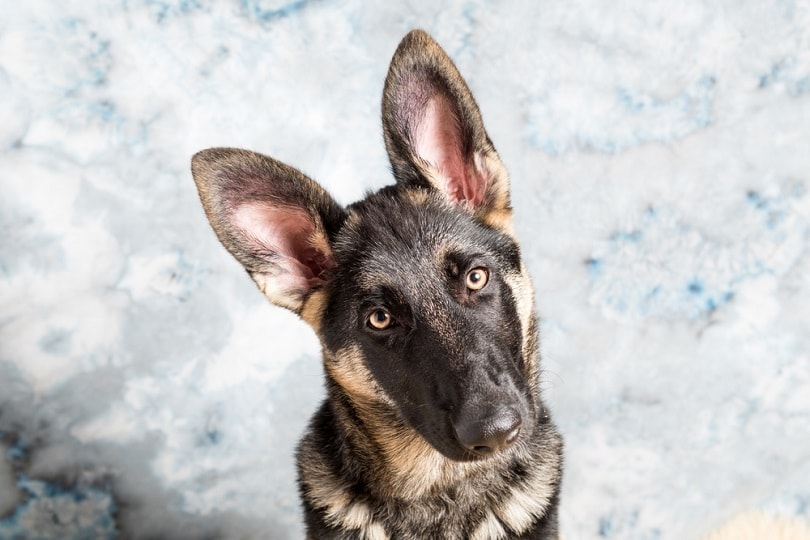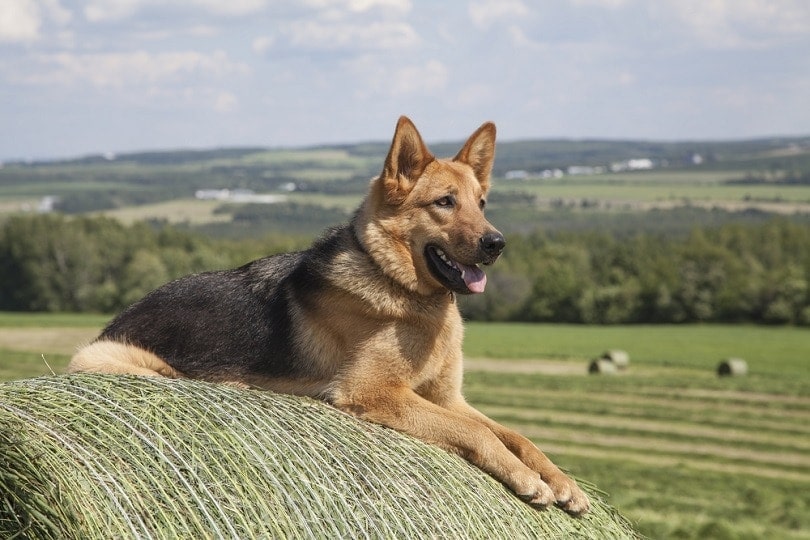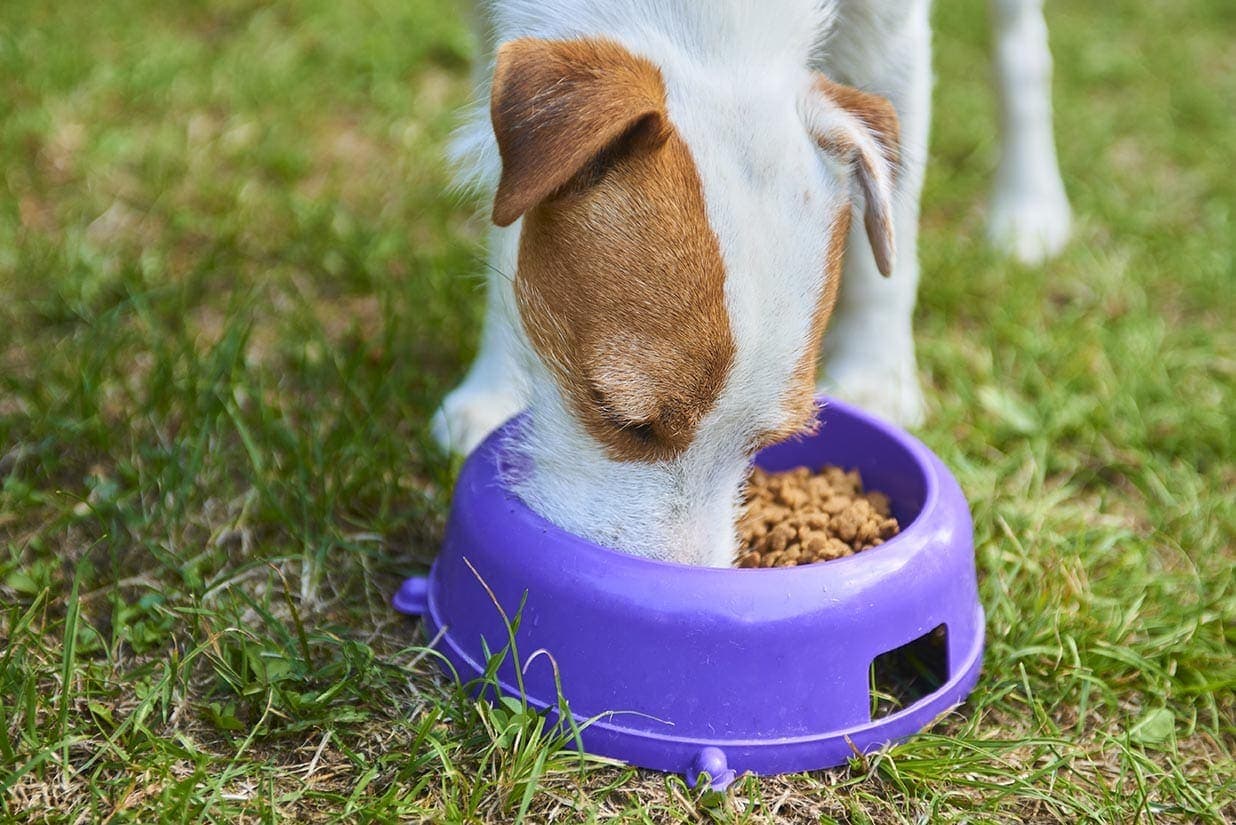How to Determine a Puppy’s Age – 7 Vet-Approved Methods To Use

Updated on

Puppies change so drastically, even in the first few weeks of life. Sometimes, it can be hard to pinpoint just how old a puppy is. Whether you’re trying to make sure your puppy is old enough to come home or you found a stray, age is important. After all, you have to figure out how much to feed them, what kind of chews they need, and how big you can expect them to get.
So, are there some physical clues to help you figure it out? Absolutely. You should be able to ballpark it using a combination of physical and mental traits.
The 7 Ways to Tell How Old a Puppy Is
1. How Well Can Your Puppy See?
During the first several weeks of life, your pup will gradually develop their sight. Vision is blurry at best once they open their eyes and it takes some time to adjust to this big world. Puppy’s eyes will open at different paces, but the whole litter should be eyes-wide-open at 2 weeks old. Their vision will improve by the day until they fully develop at 8 weeks.
There’s a widespread belief that dogs are colorblind. While their retinas work slightly differently than humans do, they can still differentiate some colors. If you want to entice your puppy, note that they see blue, violet, and yellow best. This slim spectrum is called dichromatic vision and exists in all dogs, regardless of age.
Apart from colors, if it seems like your pup can see well, they’re at least 8 weeks old. But can we narrow it down even more? Let’s move on to find out.

2. Puppy Age By Teeth
Puppies are born without teeth, but they soon develop a mouthful of needle-sharp points. If you see that your puppy has no teeth, they are likely under 3 weeks old and need their mother around the clock. Their baby teeth start erupting at around 3 weeks and finish up by 6 weeks. You won’t make a mistake about it—those little needle points hurt! But they don’t last long.
Your puppy loses their baby teeth between 12 weeks to 6 months. You might find a little tooth here and there when they start to lose them, or you might not see them at all. Your puppy might show signs of pain or discomfort during this time (called teething). You can buy teething toys to ease pain and channel energy. Offering toys with interesting textures can help keep their attention rather than gnawing on shoes.
After 6 months, even when a pup has all of their adult teeth, they will still chew if they feel the urge. So, make sure they learn good habits early on.
3. Weigh your Pup
Weight is a telltale sign of your pup’s life stage—but this is only a foolproof method when you know the breed. Many times, with mixed breeds, it can be hard to pin down. You might even know what both parents are, but that doesn’t always tell the whole story.
For instance, if the mother is significantly smaller or larger than the father, it can create a lot of size possibilities in the litter. You might have a few pups that are toward one end of the spectrum or another.
However, if you have a purebred dog, there are diagrams and charts designed to show you where they should be with growth. You can research your dog’s breed, check their current weight, and see where they fall on the scale.

4. Check Overall Body Structure
As puppies age, their overall structure changes. They go from a pudgy, bellied, clumsy ball of fluff to an older, more mature-looking dog. Even their fur changes texture as they age. Puppies are usually born with fluffy, often dense coats. When they reach 6 months, they should lose their puppy coat completely. It will be replaced with sleeker adult hair that usually sheds more. You might notice their coat color changes a little bit as the transition happens, too.
Often, you pick out a puppy and grow with them, so you don’t realize just how much they change. If you compare early on pictures of any puppy to their adolescent phase, you can see contrast differences in fur coloring. As they get older, you might notice their muscle tone, too. Puppies take a while to beef up, so they might stay thinner throughout their first few years, especially if they’re higher-energy breeds.
However, you might notice that between 6 and 12 months, muscles are much more defined in the legs than ever before. Your pup is growing into that lean teenager stage.
If you have a dog who should have pointy ears, they can take their sweet time developing. You may have adopted a German Shepherd, only to wonder when those ears are going to perk up. This whole process can take anywhere from 8 weeks to 8 months—so don’t fret if it hasn’t happened quite yet.
5. How Does Your Puppy Act?
Puppies are born barely crawling. They can’t move very well, so they slide around on their bodies, guided by tiny legs. By 4 weeks, your pups should be walking on their own. They might be a little clumsy on their feet, but they usually are pretty sturdy by the 10-week mark.
You might notice a really huge personality shift between 4 and 8 months. There are a lot of physical and mental changes happening at this time. Think of it as your dog’s angsty, pubescent stage. They might start more mischief than usual and/or be more destructive. During this stage, it’s incredibly important to enforce the rules and gain respect. Manners are crucial to this time frame—you want a well-behaved dog because of consistent training.
You shouldn’t wait for bad behavior to arise first, either. Puppies are capable of learning as soon as they come home at 8 weeks. The more you work with your puppy, the smoother the teenage stage will probably be. If your puppy isn’t quite at that rambunctious stage, they might be under 4 months but don’t rely on these signs solely. Every dog has a different personality that can influence their behavior—no matter how old they are.

6. Consider the Breed
A Mastiff at 8 weeks will be a heck of a lot bigger than a Shih Tzu at 8 weeks. So, when you’re wondering how old your puppy is, genetics says a lot. Did you see either parent? Do you know if you have a toy, small, medium, large, or extra-large breed?
The type of dog you have says a lot about what to expect as they get bigger. Once again, mixed breeds can be tricky, especially if parents differ a lot in size. Even puppies in the same litter may be all different sizes in comparison as they grow—but are all the same age.
So, while knowing the breed helps you figure out where they are, it isn’t the best method to rely on if you aren’t sure.
7. Consult a Professional
If you don’t know or you can’t tell, an animal expert can explain. When you take your new puppy in for their first check-up, they can validate or tell you just how old they estimate the pooch to be. When your vet examines your puppy, they will look them all over to see how developed they are. Usually, vets check the teeth first since they can tell a lot about a pup’s age from that alone. If you’ve adopted a puppy from a shelter or from a breeder, it doesn’t always guarantee that they are the age you were told.
Many breeders could potentially give you a 6-week-old puppy and tell you that they are 8 weeks. It’s not cool, but it can happen. So, if you bring home a puppy and they don’t seem to be eating like an 8-week-old, definitely ask a professional. Since they might not get the proper nutrition or know how to chew food well, it can be a time-sensitive matter.
So, if you bring home a puppy and they don’t seem to be eating like an 8-week-old, definitely ask a professional. Since they might not get the proper nutrition or know how to chew food well, it can be a time-sensitive matter.
If you just happened to get a rescue pup, finding out their age might be a really important thing, especially since you want to celebrate milestones. No matter your reasoning, veterinarians and animal experts devote their life to pet care—they can definitely help you out.

 How Old is a Puppy: Month-to-Month Expectations
How Old is a Puppy: Month-to-Month Expectations
Here is an overview of what you can expect at different stages.
0–3 Months

Puppies are born with their eyes and ear canals closed, making them functionally blind and deaf. They do not develop these important senses until after birth. They can barely move and rely fully on their mother. After a few days of filling up on Mama’s milk, they start to move more.
Between 14 and 21 days, their eyes open up and their vision slowly starts to come. Puppies start hearing shortly after that with hearing coming into full force by 8 weeks. By 3 months, your puppy should start to get the hang of small concepts, like potty time. Don’t be discouraged if it takes them a while. This is all very new to them!
During the first 3 months, puppies will need core vaccines to protect them from potentially fatal diseases like parvovirus, distemper, and rabies. Your vet will probably recommend getting your puppy microchipped at this point.
- DHLPP (distemper, hepatitis, leptospirosis, parvovirus, and parainfluenza)
- Rabies
4–6 Months

A major growth point lies between 4 and 6 months for pups. They go from adorable, small puppies to a terror—this is usually the most playful stage. By 6 months, your puppy will be close to their adult size. They might pack on muscle and weight throughout the next 6 months, but the bulk of the growth will be finished by the end of the sixth month.
Potty training and basic commands should be coming into full swing. Your dog should know their name, simple obedience, and the concept of potty training. You can get your pup in for a check-up at their vet for their 6-month appointment. This is also a good time to schedule or discuss options to spay or neuter as they come into sexual maturity at this point.
If you have a larger breed, some vets may suggest waiting on this procedure until they are finished growing.
6–9 Months

Between 6-9 months, you’re dealing with a teenage pup. We all know how difficult human children are during this point, so expect nothing less from your dog. They might test their boundaries, chew up your belongings, master escaping enclosures, and do lots of other pain-in-the-butt things. If you have older dogs, you may see the pup getting put in its place a lot.
It’s a very crucial time for your puppy to learn boundaries. Especially bigger breeds who might not realize just how large they are.
9–12 Months

Your puppy is rounding the corner to adulthood. They might take a little longer to mature mentally, but their bodies are just about there. You might notice a huge difference in growing speeds. They won’t be noticeably taller unless you’re paying close attention.
Most pups have finally grown into their feet, so they are less clumsy. But man oh man, are they probably naughty. This age group really gives you a run from your money. Just when you think you’re recovering from the terrible 6-month terror, they finish out the year strong.
Don’t worry, professionals say that eight to 18 months is the hardest part of raising a dog. You just have to get over that hump. Remember to have patience and understanding that your pup is just a growing guy or gal.
- DHLPP
- Rabies
12 Months & Beyond

After 12 months, the bulk of their physical growth is done. They might fill out a bit, but usually, their bone structure and organs are as they will be. Now, you just must work on getting out of the “puppy stage” completely. They will still have an abundance of energy. Even though it can be quite challenging, it will be worth it.
If you work with your dog properly, they will have awesome temperaments and able bodies.
Final Thoughts: Puppy Age
Determining the age of a puppy won’t be too hard, but it does depend on the dog. You can check at home with a few of these tips, but if you want the highest level of accuracy—ask a vet. When you take your puppy in for their routine core vaccines and check-ups, your vet can pinpoint exactly how old they think your dog is.
You want to know—after all, your puppy deserves to have a birthday celebration every year, too!
Featured image credit: Happy monkey, Shutterstock


 How Old is a Puppy: Month-to-Month Expectations
How Old is a Puppy: Month-to-Month Expectations









